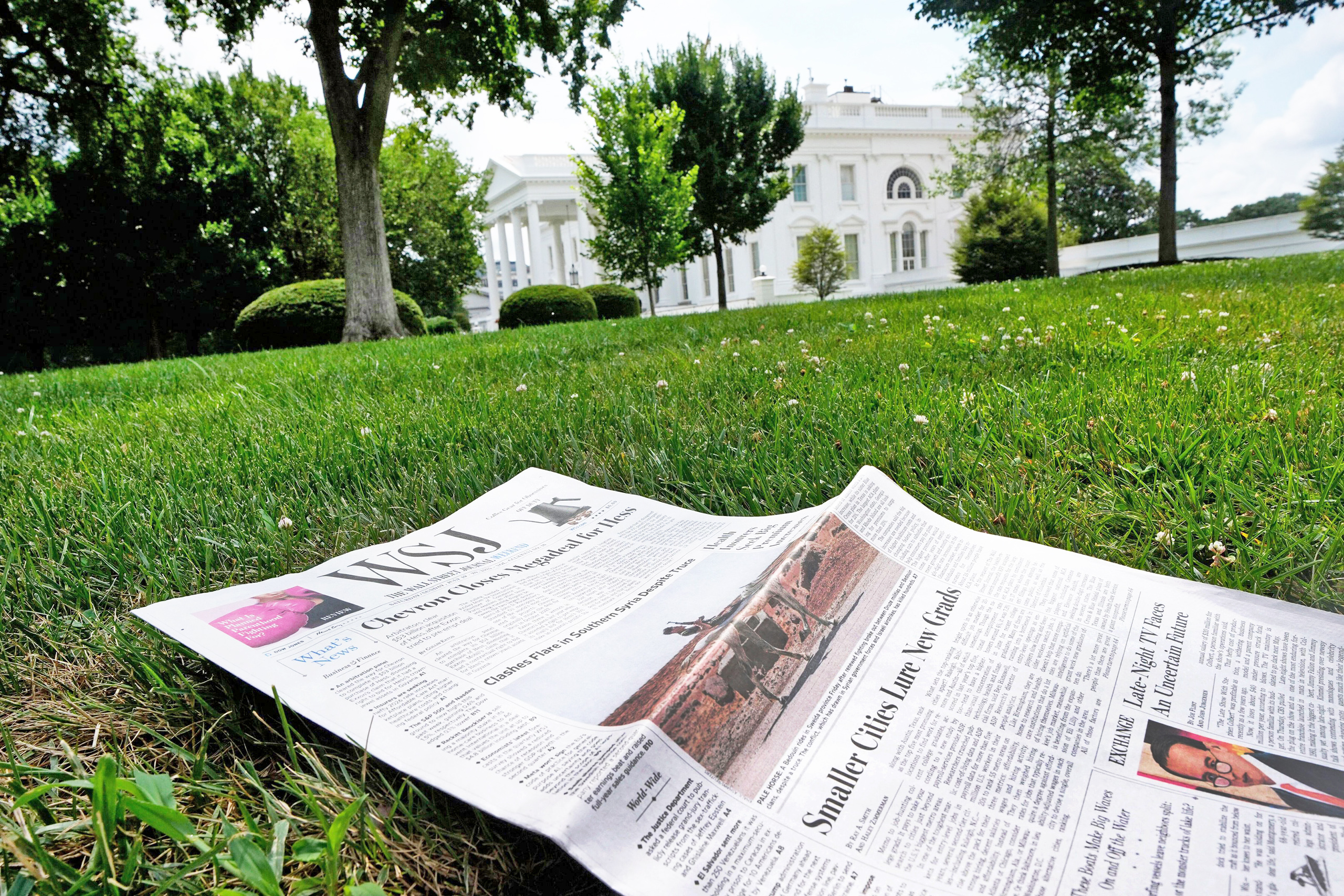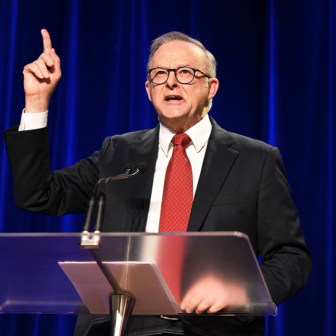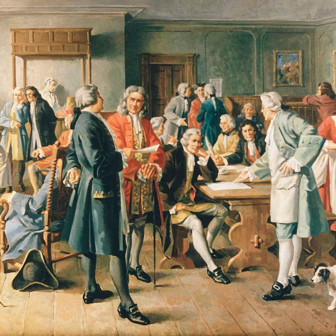Donald Trump is suing Rupert Murdoch’s Wall Street Journal for US$10 billion, more than ten times the biggest defamation settlement in American history. In the earlier case, which cost Fox News US$787 million, Murdoch’s network had baselessly and repeatedly claimed that Dominion Voting Systems’s machines were rigged to favour Joe Biden in 2020, and so corruptly changed the election result. Trump’s current action is based on a single story claiming he sent a “bawdy” birthday greeting to the serial sexual offender Jeffrey Epstein in 2003.
The offending greeting was part of a leatherbound book Epstein’s partner Ghislaine Maxwell organised for the financier’s fiftieth birthday. According to the Journal, Trump drew a pair of small arcs denoting a woman’s breasts and signed with “a squiggly ‘Donald’ below her waist, mimicking pubic hair.” Trump concluded “Happy birthday — and may every day be another wonderful secret.”
Trump’s immediate response to the Journal’s report was to sue, and to attack the article. “The Wall St Journal printed a FAKE letter, supposedly to Epstein. Also I don’t draw pictures. I told Rupert it was a SCAM, that he shouldn’t print this Fake Story. But he did, and now I’m going to sue his ass off, and that of his third rate newspaper.”
Trump’s ferocious reaction was driven by the sensitivity surrounding his relationship with Epstein, who died in prison in 2019. He and Epstein were good friends roughly from 1988 to 2004, and Epstein told journalist Michael Wolff that he was Trump’s best friend for ten years. “I’ve known Jeff for fifteen years,” Trump said in a 2002 profile of Epstein in New York magazine. “Terrific guy. He’s a lot of fun to be with. It is even said that he likes beautiful women as much as I do, and many of them on the younger side.” Epstein was a guest at Trump’s second wedding.
The relationship soured in 2004 after both men tried to buy the same oceanfront property in Palm Beach, and Trump won. They appear to have had minimal contact after that.
Epstein was arrested in 2006, and in 2008 convicted on state charges of soliciting prostitution. A secret plea deal with federal prosecutors shielded him from prosecution for much more serious charges of molesting young girls. He received a soft prison sentence of eighteen months that required him only to spend nights in jail. The following year he was released altogether and resumed his business activities and his criminal behaviour.
In November 2018, prompted partly by the new ethos of the #MeToo era, the Miami Herald’s Julie K. Brown chronicled Epstein’s victims’ stories and questioned whether prosecutors had reached a sweetheart deal with him. Partly as a result of that reporting, Epstein was charged with recruiting dozens of underage girls to his New York City mansion and Palm Beach estate between 2002 and 2005 to engage in sexual acts for money. He died before being tried for those crimes.
Epstein’s death provided fertile ground for conspiracy theorists. The official ruling was suicide by hanging (“Two guards who were meant to check on him had fallen asleep, and two CCTV cameras in front of his cell malfunctioned at the critical moment,” reported the London Daily Telegraph’s Ed Cumming) but that conclusion was challenged by Epstein’s lawyers. When the Justice Department finally released a tape of events that evening, analysts found that nearly three minutes had been cut.
Several official inquiries concluded that Epstein died by his own hand. No evidence of any intruders was ever found, and Epstein certainly faced a very bleak future: decades of jail, public humiliation and many, many legal actions against him by the women and girls he had abused.
Trump immediately tied Epstein’s death to Bill Clinton: “Epstein had an island that was not a good place as I understand it. And I was never there. So you have to ask: Did Bill Clinton go to the island?” Although he professed to have no evidence that Epstein’s death was linked to Clinton, he continued to cast doubt on the cause of death even after the New York medical examiner ruled suicide. “I want a full investigation and that’s what I absolutely am demanding,” he declared. No such investigations were published in the remaining eighteen months of his first presidency.
The idea that Epstein was murdered fitted nicely into conspiracy theories about secret paedophile rings propagated by QAnon and others. The idea that a secret cabal of Democrats, Hollywood figures and global financiers ran a global child-trafficking ring gelled neatly with their distrust of elites and deep suspicion of government institutions and the media.
Questions about Epstein sometimes resurfaced in the years leading up to the 2024 presidential election. In a 2023 podcast, for example, Kash Patel, later appointed by Trump to head the FBI, lashed House Republicans for not trying harder to force the release of an alleged list of high-powered Epstein associates. During the election campaign Trump said he would declassify the Epstein files and was willing to release them. In October vice-presidential candidate J.D. Vance declared, “Seriously, we need to release the Epstein list. That is the important thing.”
That seemed a real prospect in the first several months of Trump’s second presidency. Attorney-general Pam Bondi said Epstein’s “client list” was “sitting on my desk right now for me to review,” an imminent release of documents would contain “a lot of information,” and Americans would “get the full Epstein files.” The justice department had received a new “truckload of evidence,” said Bondi, including “tens of thousands of videos of Epstein with children or child porn, and “everything’s going to come out to the public. Americans have a right to know.” Trump declared that “100 per cent of all these documents are being delivered.”
A change in tone came around mid-May. On 16 May the two top FBI officials, Patel and Dan Bongino, both previously strong proponents of claims about Epstein, appeared together on Fox News and said Epstein had indeed died by suicide. Since then, several sources have claimed that Trump was told in the first weeks of May that he figured multiple times in the files, not necessarily engaged in illegalities but certainly mentioned in ways that would be politically embarrassing.
The first prominent person to publicly link Trump’s likely appearances in the files to the government’s behaviour was Elon Musk. On 5 June, at the height of his public feud with the president, he declared that Trump wasn’t releasing the Epstein files because he was in them.
Trump’s base wasn’t prepared, however, for the sharp reversal that came early the following month. Over the July holiday weekend leaders of the attorney-general’s department and the FBI approved a statement conceding that Epstein had indeed committed suicide; that there was no client list; that no unreleased evidence would “expose any additional third parties to allegations of illegal wrongdoing”; and that, in order to protect the privacy of victims, no further documents would be released.
Divisions within the blindsided MAGA base were soon on full display. Trump confidante and ally, Steve Bannon spent weeks in his War Room podcast — a propaganda mainstay of the MAGA movement — trying to pressure Trump to release all the files. According to Fox News host turned podcaster Tucker Carlson, “Even people who are fully on board with the bulk of the MAGA agenda are like, ‘This is too much, actually.’”
Most strident was prominent MAGA congresswoman Marjorie Taylor Greene: “If you tell the base of people who support you, of deep state treasonous crimes, election interference, blackmail, and rich powerful cabals, then you must take down every enemy of the People. If not, the base will turn and there’s no going back. Dangling bits of red meat no longer satisfies. They want the whole steak dinner and will accept nothing else.”
While Trump supported the claims of a cover-up before he regained the presidency, now he wanted the whole Epstein thing to go away. As early as 8 July, he lashed out at reporters: “Are you still talking about Jeffrey Epstein? This guy’s been talked about for years. I can’t believe you’re asking a question on Epstein [when the Texas floods are so urgent].”
“We had the Greatest Six Months of any President in the History of our Country,” he declared on Truth Social, “and all the Fake News wants to talk about is the Jeffrey Epstein Hoax.” Early in July his message was simply to move on: “He’s been dead a long time… I don’t knw what the… fascination is.” Soon, however, it became a Democrat plot: “a hoax that’s perpetrated by the Democrats. And some stupid Republicans and foolish Republicans fall into the net.” The Epstein “files,” were “made up” by former FBI head James Comey. “They were made up by Obama. They were made up by Biden.”
But Trump’s efforts to persuade much of his base failed signally. One MAGA operative observed: “Villainising your base for caring about the thing you told them to care about is never a good strategy.”
It was into this combustible mix that the 17 July Wall Street Journal article landed. And it was Trump’s angry reaction to the publication of his birthday greeting to Epstein that gave the story such oxygen.
The Journal’s article was interpreted by many as a deliberate attack by Murdoch on Trump. The strongest proponent of this view was Steve Bannon. “This is a [political] kill shot by Murdoch,” he told journalist Peter Hartcher. “Murdoch has done it because he is in league with the deep state, which is out to destroy Trump.” Bannon predicted that “all of MAGA will rally around because of the attack on President Trump.” This, he added, will “blow up the Murdoch empire in the US.”
But treating the Journal report as part of a determined anti-Trump move by Murdoch overlooks key facts. Murdoch’s main two American outlets have prospered under Trump, though for different reasons. Fox News is attracting almost three million viewers in prime time, putting it well ahead of its cable news competitors and even ahead of the free-to-air networks. It has prospered by reinforcing the messages MAGA wants to hear.
The Journal has also prospered, though among a very different audience. Always much less of a propaganda outlet than its stablemate, it must maintain credibility with an audience that would otherwise go to another high-quality newspaper, such as the New York Times. It has maintained a more mainstream, pre-Trump Republican editorial line, consistently critical of Trump’s high tariff policies for instance. One editorial called Trump’s tariff plans “the dumbest trade war in history.”
Perhaps most importantly, the offending story seems likely to have been bottom-up rather than top-down: the work of WSJ reporters discovering and verifying the key facts rather than the result of a management directive. Thus, the question for the paper’s and company’s management was: should the story be suppressed? If the Journal had suppressed it, the self-censorship would have become public and damaged the paper’s reputation.
Further evidence that this is not a campaign driven from the top is the response of other Murdoch media. Since the Journal report, Fox News and the New York Post have largely stayed quiet on the matter. Fox News has only mentioned Trump’s lawsuit a couple of times in passing.
Indeed, soon after the Journal story was published, Fox News host Laura Ingraham, who was on air, told her audience that straight after the break news would be coming of a scoop by the Journal. Yet no mention of it followed, and Ingraham spent the remaining twenty minutes of her program on unrelated topics.
Trump himself saw the difference. Within hours of denouncing the Journal, he was effusive about Fox: “Everybody should watch Sean Hannity tonight. He really gets it. 9PM ET Fox News.”
The response of Murdoch’s Australian flagship, the Australian, has also been decidedly tepid. While the Sydney Morning Herald, the Age and Australian Financial Review have run several long and penetrating articles on the confrontation between Murdoch and Trump, in the first several days the Australian merely reported that the White House had taken away the Journal’s seat in the press pool on Air Force One. This lack of interest in such a newsworthy topic might suggest the Murdochs would like the story to go away, or perhaps that their editors are not yet clear on what line they should take.
While commercial and political pragmatism might suggest that both sides have an interest in de-escalating, so far there is no sign of this. One obstacle seems to be the personal antipathy between the two leading players. As is his wont, Trump framed his threat in personally demeaning terms: “I look forward to getting Rupert Murdoch to testify in my lawsuit against him and his pile of garbage newspaper, WSJ. That will be an interesting experience!!!” In turn, Murdoch is reported to have told associates “I am ninety-four years old and I will not be intimidated.”
Nor is there any sign of the Journal backing down. The paper would “vigorously defend” itself against the lawsuit, it said, and it has full confidence in the rigor and accuracy of our reporting. Since then it has published a follow-up article asserting that Trump was mentioned in the Epstein files. And then, on 24 July, it ran a front page article claiming that Bill Clinton, several major corporate figures and British ambassador Peter Mandelson all wrote greetings in Epstein’s now-notorious birthday book.
When Trump launched his case against the Journal, one law professor commented that the complaint was “full of sound and fury but lacks legal merit.” This second story on the birthday book strongly suggests the paper either has a copy or has seen (and photographed?) it, which means Trump’s case will collapse. Trump also claimed he doesn’t “do” drawings, even though four of his drawings were sold during his first presidency. Nor is there any sign that Murdoch or others are displeased with the Journal. In recent weeks it has been more of a nationally prominent agenda-setter than it has been for years.
Trump is unlikely to make any progress on the legal front, and he has been equally unable to shift the political coverage. His most determined effort came on 21 July when he released the (deeply flawed) report of his director of national intelligence, Tulsi Gabbard, refuting claims of Russian interference in the 2016 election. Trump’s response was immediate: “Obama himself manufactured the Russia, Russia, Russia HOAX. Crooked Hillary, Sleepy Joe and numerous others participated in this, THE CRIME OF THE CENTURY! Irrefutable EVIDENCE. A major threat to our Country!!!”
Even amid his unrestrained comments Epstein was lurking. The Gabbard records are “the most unbelievable thing I think I’ve ever read,” he said. “So you ought to take a look at that and stop talking about [the Epstein] nonsense.”
Despite the pyrotechnics — Trump’s posts including an AI-generated video of Barack Obama being arrested in the Oval Office — he failed to change the political agenda, perhaps because, as Washington Post’s fact-checker Glenn Kessler pointed out, there had already been four inquiries into Russia interference claims, including one led by Marco Rubio when he was in the Senate, which reached completely bipartisan findings.
The conventional wisdom is that Trump is scandal-proof. Already, for example, twenty-eight women have accused him of sexual assault or harassment, but his political career has continued to prosper. A key difference this time round is that the Republican base is so split. Congress is in its summer recess; indeed, it adjourned a day early precisely because the Republican leadership wanted to stop a bipartisan effort to release the Epstein material. Trump will hope that the heat of the affair dissipates over summer. If the scandal keeps metastasising when Congress returns, Rupert Murdoch will be the least of Trump’s worries. •
From the archive: Rupert Murdoch and Donald Trump have had their ups and downs, but it’s mainly been down since 2020, reported Rod Tiffen in April last year.




